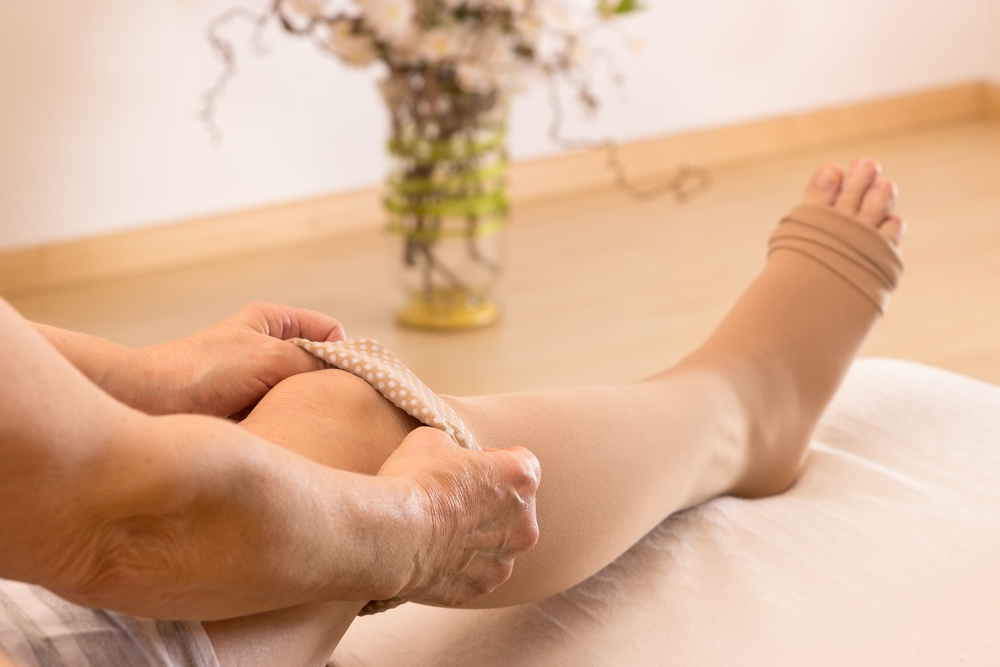- Compression garments are most commonly associated with body contouring procedures, but they are also used after facial plastic surgery.
- By providing increased comfort and circulation, surgical compression garments help speed up the healing process.
- Popular brands include Marena, Caromed, and Isavela, but in some cases a simple roll of ACE bandage is all it takes.
Most invasive cosmetic procedure, like tummy tucks and liposuction, are followed by lengthy recovery periods. While you are undoubtedly excited to look your best, it is important to follow your doctor’s post-op instructions.
One of the key instructions that doctors typically give is to wear a compression garment during recovery. Though not exactly fashionable, compression garments help to ensure both proper healing and the best results possible.
We asked four top plastic surgeons about the best compression garments on the market, and how they can be used to improve post-procedure recovery. Here’s what they had to say.

How long should compression garments be used?
Compression garments are among the most important components of the recovery process for a wide variety of procedures, according to most cosmetic surgeons.
“It’s hard to overstate the importance of compression dressings,” says Dr. Taylor Pollei, a facial plastic surgeon with offices in Beverly Hills and Mission Viejo, CA. “Something so simple can really make a dramatic difference in the surgical outcome.”
That said, we found that instructions on their use can vary from one practice to another. How long and in which way compression garments need to be worn are within a surgeon’s discretion.
“It all depends on the surgical procedure, the patient’s recovery, and the surgeon’s preference,” Boston-based plastic surgeon Dr. Samuel Lin explains. “There’s no definitive consensus, with some plastic surgeons recommending patients wear compression garments for one, three, four, or six weeks. Sometimes, compression may be required for even longer periods of time.”
Some surgeons may also recommend that a more casual garment be worn after the initial swelling and bruising has subsided, although this isn’t always necessary.
Englewood, CO plastic surgeon Dr. Greg Buford feels that compression garments are most beneficial for body contouring procedures.
“During the early phases of healing, compression helps to reduce the overall swelling and maintain an even contour,” Buford says. “In my practice, we use these garments for anyone undergoing liposuction, a tummy tuck, or both.”
For facial compression garments the duration is much shorter, according to Pollei. “I prefer that patients wear the facial compression wrap for 24 hours straight following surgery,” he says. “I then see them in the office to remove the dressing and check the surgical areas.”
During this follow-up appointment Pollei replaces the dressing with a slightly less cumbersome version, which then stays in place for an additional 24 hours. At that point the patient can replace the gauze or elastic wrap on their own, or use a textile or fabric wrap if they prefer.
While compression garments are primarily used to manage swelling, they can also help to reduce the chances of additional complications.
For example, seromas — lymph fluid that builds up under the surface of the skin — are particularly likely if compression garments are improperly used after a tummy tuck procedure. In some cases, medical intervention might even be required to drain seromas.
What makes a good compression garment?
Perhaps the most important aspect of selecting a compression garment is the fit.
“A good compression garment will fit the patient appropriately. It will be taut and snug, but not too tight,” says Buford. “The garment should also cover the areas that were treated and not leave anything exposed. When this happens, there’s often a clear delineation between the area that was covered and the area that wasn’t.”
Lin concurs: “Fit is definitely one of the most important factors, both for comfort and adequate tightness,” he says. “When selecting the right garment, it’s best to find one that fits snugly but isn’t so tight that it cuts off circulation. It should also be washable.”
According to Dr. Andrew Trussler, a plastic surgeon based in Austin, determining the right fit can be challenging because doing so requires predicting the circumference of the body area post-procedure, while factoring in the patient’s height and the length of their trunk and limbs.
Trussler notes that other aspects such as duration of wear, color (black garments better camouflage drainage), and the location of any zippers or clasps (to avoid injuring incision lines and skin) also need to be considered.
Cost shouldn’t be much of a factor when deciding which brand to choose as, in the grand scheme of things, garments are fairly inexpensive.
According to Buford, body compression garments typically cost about $150. Lin says that the garments he recommends run anywhere from $30 to $150, while Pollei says the prices of facial cosmetic surgery garments typically range from a mere $5 to $30.
What type of compression garment do you need?
The type of compression wear that you choose or is given to you will largely depend on the procedure that you underwent, and may cover an area that extends well beyond the actual surgical site.
The following are some of the most common compression garments:
- Mid thigh girdles — These extend from from the thigh to the abdomen, just below chest. Both legs pass through the girdle, giving the appearance of extremely high waisted shorts. The mid thigh girdle is ideal for procedures in the buttocks, thigh, and abdominal regions.
- Compression girdles — Covering the area from the buttocks to the upper chest, compression girdles resemble mid thigh girdles without the portion of the garment that covers the thigh. These girdles are used following tummy tucks and liposuction in the abdomen area.
- Compression stockings — Essentially, these are tight stockings that end just above or below the knee, depending on the model. Compression stockings can be employed following procedures outside of the leg region to improve overall blood circulation and to prevent deep vein thrombosis, a form of blood clotting.
- Surgical bras — Depending on the model, surgical bras can either resemble a sleek sports bra or a bulkier chest-level vest. These bras are used not only following breast augmentations, but also for breast reconstruction following trauma and mastectomies as a result of breast cancer.
- Compression arm sleeves — These sleeves extend from the wrist to the shoulder, with certain models wrapping around the fingers and thumb like a fingerless glove. Similar to compression socks, compression sleeves can be used following procedures outside of the arm region to improve overall circulation.
It is worth noting that it can be difficult to determine what size of garment you will need following surgery. Sizing is complicated by a combination of factors including any implanted materials and swelling. It is important to speak with your doctor, and to consult the appropriate manufacturer’s sizing charts before making any purchases.
Which brand of compression wear is best?
Some surgeons, like Buford, have a clear preference for certain brands of compression garments. “We use Clearpoint Medical garments for our body contouring patients,” he says. “We find their garments fit the best among the various brands, and are quite reasonably priced.”
Others use different post surgical compression garments for different procedures and situations. Trussler is one such surgeon — below are his top picks.
Tummy tuck and liposuction
Top pick: Abdominal binder or above-knee to chest garment, depending on the areas of combination liposuction.
Trussler recommends a black tummy tuck and liposuction compression garment because it fits well and is easy to use. His expert advice is to wear it for two to three weeks, and then transition to 12 hours on and 12 off for another three weeks.
Brazilian butt lift
Top pick: Butt lift garment with a lighter buttock cut out, which helps to compress the areas around the buttock and protects the central area of fat grafting.
“It unzips all the way to the leg so it is very easy to put back on around the buttock,” Trussler notes.
Thigh lift
Top pick: Above- or below-knee to chest garment with a transition to Spanx after two to three weeks.
“Above- or below-knee to chest garment provides even compression and is comfortable and gentle on the incisions,” Trussler says. “The zipper and clasps are not sharp or firm, and they are easy to get back on.”
Arm lift (brachioplasty)
Top pick: ACE bandages for two to three days only, and then a sleeve for post-surgical compression for one week.
Trussler notes that it’s hard to find a comfortable sleeve that contours to the individual arms and is gentle enough on the incisions. “Most compression will promote swelling in the hands, which patients don’t like,” he says.
Chest contouring for men
Top pick: ACE wraps for two to three days.
Trussler likes this option because it is hard to get even compression with a compression vest. After three days Trussler encourages patients to wear a tight athletic shirt under their clothing for an additional two to three weeks.
Facelift and other facial plastic surgery procedures
For face and neck lifts Trussler recommends patients wear a compressing but bulky Kerlix and Coban dressing for only 12 hours. He says that these procedures don’t require compression, which can apparently injure the skin.
In contrast, Pollei does use compression garments for these procedures, but has no specific preference.
“There is no specific brand of wrap that is superior, but there are two types of wraps utilized,” Pollei says. “The first is the compression dressing placed following surgery, which usually includes gauze and some type of elastic wrap such as Coban, cling, or a similar bandage. This has the ability to absorb any drainage, blood, or fluid present immediately following surgery. The second type is usually a textile or fabric-based wrap that can be removed and replaced, often with Velcro as a fastening device.”
For the second stage, Pollei usually instructs his patients to begin wearing the garment about three days post-surgery and for the next several days (or weeks if they prefer) after that. It is often worn only at night.
It’s only temporary
Remember that while compression garments may feel cumbersome at times, they are not permanent. “Most patients are very excited to come out of the garment and start using Spanx or compression athletic wear,” Trussler says.
“You’ll most probably be wearing your compression garments for at least two weeks — the bottom line is to make sure they’re comfortable.”









